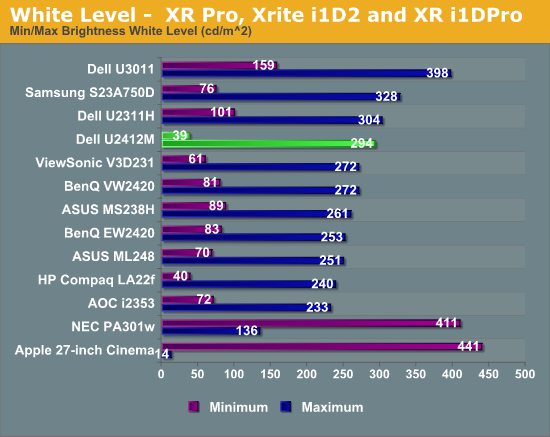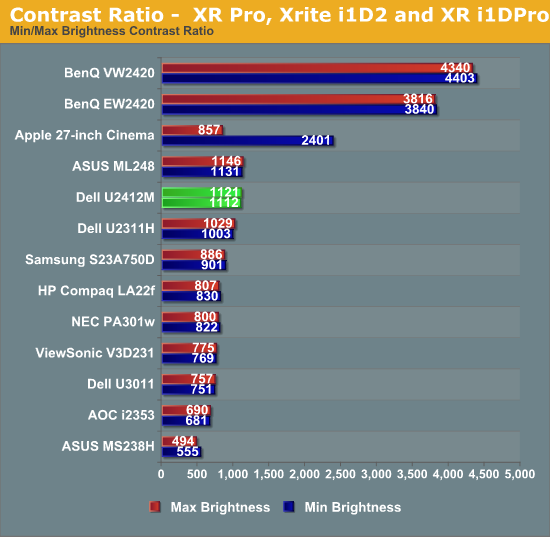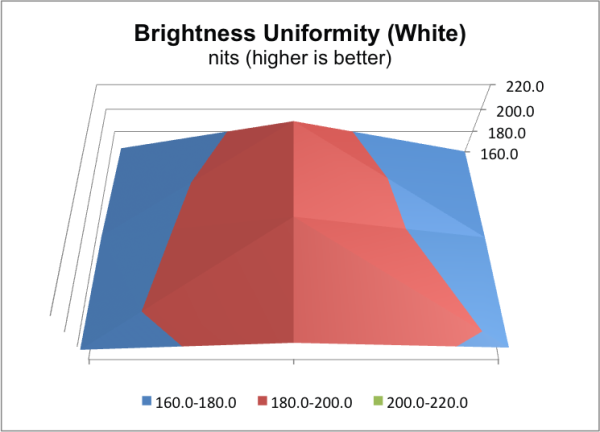Dell U2412M - 16:10 IPS without Breaking the Bank
by Chris Heinonen on February 28, 2012 9:00 AM ESTDell U2412M Brightness and Contrast
Despite the larger size of the display compared to recent 23” monitors I have reviewed, the U2412M says it can produce 300 nits of light at maximum output, which should certainly be bright enough for anyone to use. It’s worth noting that I usually set the display around 5 nits too high before calibration, to allow for a little headroom when ColorEyes generates the curves. However this also means that maximum light output, once calibrated, might be around 5% lower than maximum due to the curves inside the ICC profile.

Despite this possible limitation, the Dell still put out 294 nits at maximum brightness after calibration, and 39 nits at minimum brightness. This was plenty bright for my work area, even with bright overhead lights, and the combination of the high brightness and anti-glare coating made it easy to see the screen.
The weak area for IPS screens has always been the black levels, with them being much higher than those from VA based displays. The U2412M did well here, out performing all recent non-VA displays with a nice, low black level.

With this combination of black level and a very bright screen, we would expect to see a decent contrast ratio to come out as well, and the Dell delivers here.

Beating the specified number by over 10% is always nice to see, and the contrast on the Dell is very nice. It easily outperforms most TN displays, though it's not able to compete with the combination of LED lighting and a VA panel from BenQ. It was also very stable across the spectrum, with virtually identical ratios at maximum and minimum brightness.
While the center stayed nice and bright, the edges showed a good amount of fall off in comparison, and an overall variance of around 6%. The areas with higher brightness uniformity issues were also the areas with higher dE values on the uniformity testing, just as we expected. Looking at black uniformity, thanks to the bright corners this wound up even worse, with a variance of around 14%.
Taken as a whole, the contrast ratios are good, and while there is light fall-off at the edges of the display, it does not seem to have a noticeable effect on color quality.












143 Comments
View All Comments
ryedizzel - Tuesday, February 28, 2012 - link
+1cheinonen - Tuesday, February 28, 2012 - link
Can you provide any more feedback, or examples, on why you feel this way? Of course I don't want to alienate readers with my writing style.jamyryals - Tuesday, February 28, 2012 - link
He's posting about a commenter, not you Chris.cheinonen - Tuesday, February 28, 2012 - link
Ah, I missed the subject heading there as I was reading through the comments. Sorry about that!bobsmith1492 - Tuesday, February 28, 2012 - link
Pot... kettle. Don't mind this troll, Mr. Heinonen.ryedizzel - Tuesday, February 28, 2012 - link
I guess I am one of the few that actually wants a 1080p monitor! My PC sits next to the 46" living room TV and its much easier to mirror the resolution on my desktop for watching movies or playing games using the wireless Xbox controller adapter.I'm just dying for a 120Hz passive 3D monitor to hit the market before I upgrade.... or OLED. ;)
Zoomer - Tuesday, February 28, 2012 - link
This monitor can do that just fine.TerdFerguson - Tuesday, February 28, 2012 - link
Great review, thanks.phantom505 - Tuesday, February 28, 2012 - link
I went ahead and bought the AOC. As far as image quality goes, it doesn't seem like this does that much better, but you look at it much more favorably, which is odd. Now I'm not a fan of the brushed chrome, and I hate the stand, but I don't see how having a slightly larger aspect ratio makes this better than the AOC. I guess the color and stand might, but I find that hard to believe for $100 improvement.I'm more curious the ASUS Artistic series (or whatever they call it) performs with claims of low dE and 98% of the Adobe RGB gamut.
cheinonen - Tuesday, February 28, 2012 - link
The AOC did very well for the price, as getting the eIPS display for under $200 is nice. The Dell was very close as far as color accuracy, but had the extra resolution, far better stand, USB hub, better contrast ratio (when it comes to displays, contrast ratio winds up being more important than anything else for seeing a clear difference side-by-side), better black level, and a nicer UI. The extra inch isn't important to me really, but it also stands out more relative to other displays due to the panel technology and aspect ratio.I'm working to get a review of the ASUS ProArt series in the future, as I'm very interested as well.